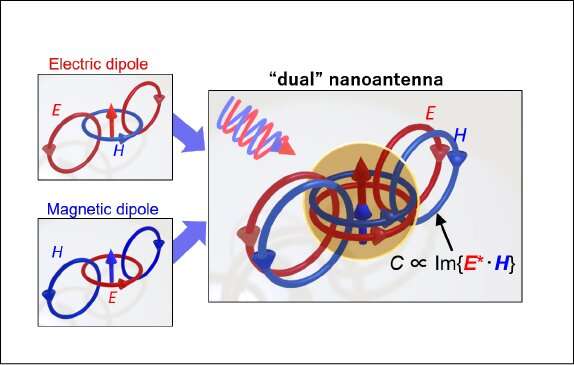
A research group from Kobe University in Japan have proposed and tested a nano-antenna that uses the specific optical resonance of dielectric nanoparticles to form a near field of circularly polarized light. This technique bolsters the circularly polarized light-selective response of chiral molecules. The results of this study should provide applications in chirality analysis and asymmetric photochemical reactions for biomolecules, chemical substances, and pharmaceuticals.
“Chirality” refers to the property of a substance that cannot be superimposed on its mirror image. Since the mirror image isomers of chiral molecules have significantly different physiological effects, there is great demand in the life science and pharmacology fields for new technologies to identify and sort mirror isomers efficiently.
Detection methods and photochemical reactions are available that utilize the difference in optical absorption for left and right circularly polarized light (circular dichroism) in chiral molecules, but analysis using these existing techniques requires high sample concentrations and significant measurement times. These requirements stem from the minuscule absorption difference between left and right circularly polarized light due to the small size of chiral molecules relative to the helical pitch of such light.
Increasing circular dichroism requires a technology that creates enhanced fields with circular polarization in nanoscale regions smaller than optical wavelengths. Optical chirality, a measure of the enhanced field of circular polarization, is maximized when both the electric and magnetic fields are enhanced, and the direction of handedness of the incident circular polarization (helicity) is preserved. However, conventional nano-antennas (e.g., metal nano-antennas with localized surface plasmon resonance) resonate with the incident electric field, but their response to the incident magnetic field is minimal, blocking helicity preservation. Therefore, developing a new type of nano-antenna that resonates in both electric and magnetic fields is necessary.
This study, published in Nano Letters, focused on the Mie resonance of dielectric nanoparticles with a high refractive index. Mie resonances include electric and magnetic dipole resonances (Figure 1, left), and dielectric nanoparticles with low-order Mie resonances in light frequency ranges can enhance both incident electric and magnetic fields. Such nanoparticles are electromagnetically symmetric and termed “dual” nano-antennas (Figure 1, right).
Dual nano-antennas enhance optical chirality with their two resonances, even though these nano-antennas have an achiral structure. In this case, the scattered light from the resonance preserves the incident light’s helicity (handedness of circular polarization). In this study, the research group developed a new type of nano-antenna that can both boost electromagnetic fields and maintain circular polarization using Mie resonances in the visual and near-infrared spectrums.
First, the researchers calculated the helicity density of optical resonance in silicon nanoparticles based on the Mie theory. They demonstrated that these particles preserve the helicity of incident circularly polarized light under Kerker conditions—equal intensity and phase in the electric and magnetic dipole resonances—forming a near field of circularly polarized light.

To demonstrate this property, the research group used a colloidal solution of crystalline silicon nanoparticles that they developed independently. Figure 2(a) shows a photograph of colloidal solutions of differently sized silicon nanoparticles. Suppressing the size distribution to less than 5% results in vivid scattering coloration.
The team constructed a setup to accurately measure the right- and left-handed circularly polarized components of the scattered light when the nanoparticles are irradiated with clockwise circularly polarized light, obtaining the helicity density spectrum. Particles without this “dual” resonance (e.g., gold nanoparticles) exhibit changes in the scattered light polarization, as shown in Figure 2(b), and do not preserve the incident light helicity.
The helicity density is nearly zero in both experiments and calculations, as shown in Figure 2(c). Meanwhile, “dual” nanoparticles satisfying the Kerker conditions preserve the scattered light helicity of the incident circularly polarized light (Figure 2(d)). The colloidal solution of silicon nanoparticles shown in Figure 2(e) allows the helicity density to reach a theoretical value of 0.96 and an experimental value of 0.7 at a wavelength of around 680 nm.
This result indicates the formation of a circularly polarized near field on the nanoparticle surface. The research group has performed similar measurements on silicon nanoparticles with average diameters ranging from 114 to 179 nm and demonstrated that helicity conservation of incident circularly polarized light is possible in wavelengths of 550 to 750 nm.
Near fields of circularly polarized light enhance the interaction between light and chiral molecules. This effect improves the circular dichroism of chiral molecules, enabling highly sensitive detection and analysis and increasing the efficiency of asymmetric photochemical reactions, with potential applications in the pharmaceutical field. Moreover, the developed nanoparticle solution has potential as a new liquid for controlling light polarization.
More information:
Hidemasa Negoro et al, Helicity-Preserving Optical Metafluids, Nano Letters (2023). DOI: 10.1021/acs.nanolett.3c01026
Provided by
Kobe University
Citation:
Researchers develop a nano-antenna that forms a near field of circularly polarized light (2023, June 28)
retrieved 28 June 2023
from https://phys.org/news/2023-06-nano-antenna-field-circularly-polarized.html
This document is subject to copyright. Apart from any fair dealing for the purpose of private study or research, no
part may be reproduced without the written permission. The content is provided for information purposes only.



![The Request Failed due to a Fatal Device Hardware Error [2025 Lastest]](https://lbnntv.com/wp-content/uploads/2025/07/The-Request-Failed-due-to-a-Fatal-Device-Hardware-Error-120x86.png)






